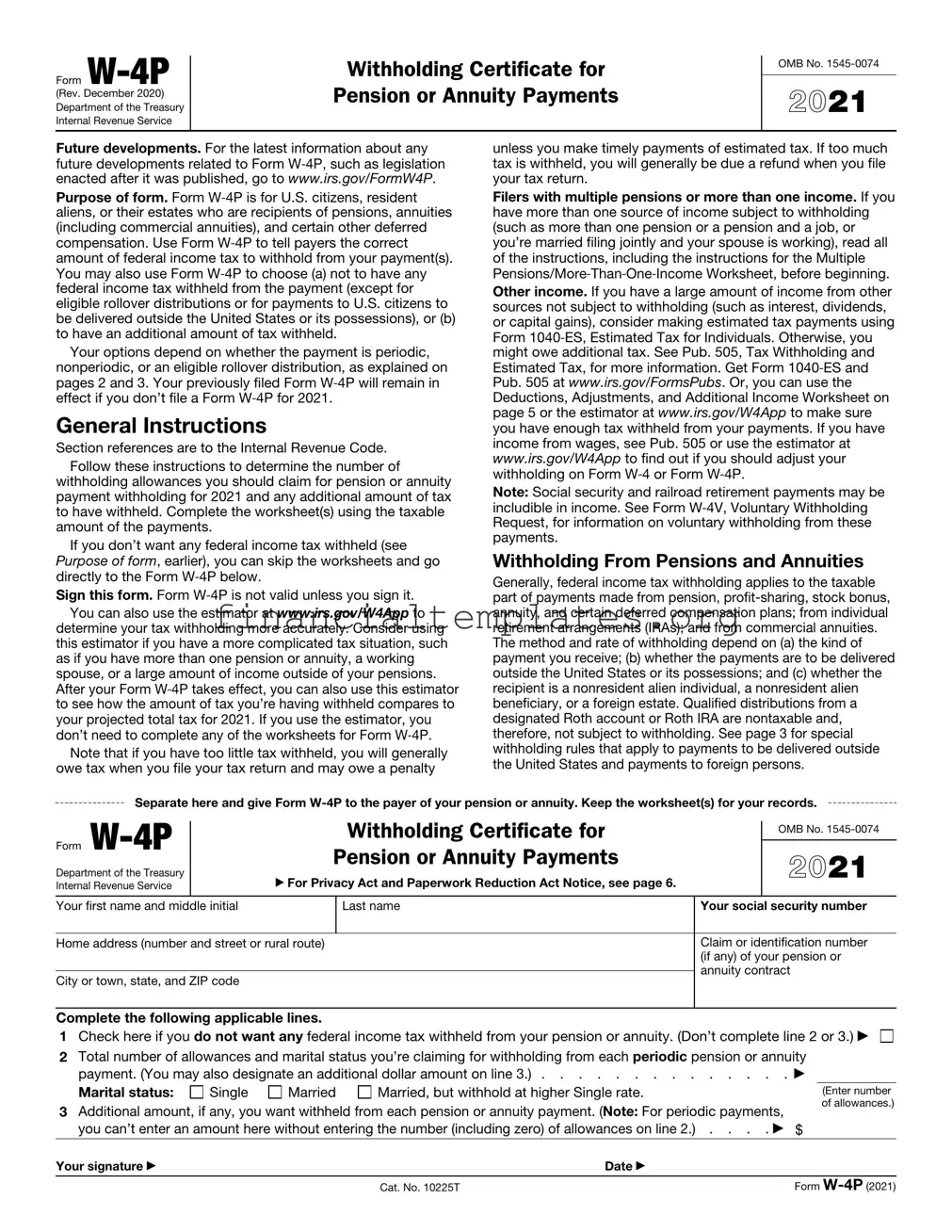General Instructions
Section references are to the Internal Revenue Code.
Future developments. For the latest information about any future developments related to Form W-4P, such as legislation enacted after it was published, go to www.irs.gov/FormW4P.
Purpose of form. Complete Form W-4P to have payers withhold the correct amount of federal income tax from your periodic pension, annuity (including commercial annuities), profit-sharing and stock bonus plan, or IRA payments. Federal income tax withholding applies to the taxable part of these payments. Periodic payments are made in installments at regular intervals (for example, annually, quarterly, or monthly) over a period of more than 1 year. Don’t use Form W-4P for a nonperiodic payment (note that distributions from an IRA that are payable on demand are treated as nonperiodic payments) or an eligible rollover distribution (including a lump-sum pension payment). Instead, use Form W-4R, Withholding Certificate for Nonperiodic Payments and Eligible Rollover Distributions, for these payments/distributions. For more information on withholding, see Pub. 505, Tax Withholding and Estimated Tax.
Choosing not to have income tax withheld. You can choose not to have federal income tax withheld from your payments by writing “No Withholding” on Form W-4P in the space below Step 4(c). Then, complete Steps 1a, 1b, and 5. Generally, if you are a U.S. citizen or a resident alien, you are not permitted to elect not to have federal income tax withheld on payments to be delivered outside the United States and its possessions.
Caution: If you have too little tax withheld, you will generally owe tax when you file your tax return and may owe a penalty unless you make timely payments of estimated tax. If too much tax is withheld, you will generally be due a refund when you file your tax return. If your tax situation changes, or you chose not to have federal income tax withheld and you now want withholding, you should submit a new Form W-4P.
Self-employment. Generally, you will owe both income and self-employment taxes on any self-employment income you (or you and your spouse) receive. If you do not have a job and want to pay these taxes through withholding from your payments, you should enter the self-employment income in Step 4(a). Then compute your self-employment tax, divide that tax by the number of payments remaining in the year, and include that resulting amount per payment in Step 4(c). You can also add half of the annual amount of self-employment tax to Step 4(b) as a deduction. To calculate self-employment tax, you generally multiply the self-employment income by 14.13% (this rate is a quick way to figure your self-employment tax and equals the sum of the 12.4% social security tax and the 2.9% Medicare tax multiplied by 0.9235). See Pub. 505 for more information, especially if your self-employment income multiplied by 0.9235 is over $147,000.
Payments to nonresident aliens and foreign estates. Do not use Form W-4P. See Pub. 515, Withholding of Tax on Nonresident Aliens and Foreign Entities, and Pub. 519, U.S. Tax Guide for Aliens, for more information.
Tax relief for victims of terrorist attacks. If your disability payments for injuries incurred as a direct result of a terrorist attack are not taxable, write “No Withholding” in the space below Step 4(c). See Pub. 3920, Tax Relief for Victims of Terrorist Attacks, for more details.
Specific Instructions
Step 1(c). Check your anticipated filing status. This will determine the standard deduction and tax rates used to compute your withholding.
Step 2. Use this step if you have at least one of the following: income from a job, income from more than one pension/annuity, and/or a spouse (if married filing jointly) that receives income from a job/pension/annuity. The following examples will assist you in completing Step 2.
Example 1. Bob, a single filer, is completing Form W-4P for a pension that pays $50,000 a year. Bob also has a job that pays $25,000 a year. Bob has no other pensions or annuities. Bob will enter $25,000 in Step 2(b)(i) and in Step 2(b)(iii).
If Bob also has $1,000 of interest income, which he entered on Form W-4, Step 4(a), then he will instead enter $26,000 in Step 2(b)(i) and in Step 2(b)(iii). He will make no entries in Step 4(a) on this Form W-4P.
Example 2. Carol, a single filer, is completing Form W-4P for a pension that pays $50,000 a year. Carol does not have a job, but she also receives another pension for $25,000 a year (which pays less annually than the $50,000 pension). Carol will enter $25,000 in Step 2(b)(ii) and in Step 2(b)(iii).
If Carol also has $1,000 of interest income, then she will enter $1,000 in Step 4(a) of this Form W-4P.
Example 3. Don, a single filer, is completing Form W-4P for a pension that pays $50,000 a year. Don does not have a job, but he receives another pension for $75,000 a year (which pays more annually than the $50,000 pension). Don will not enter any amounts in Step 2.
If Don also has $1,000 of interest income, he won’t enter that amount on this Form W-4P because he entered the $1,000 on the Form W-4P for the higher paying $75,000 pension.
Example 4. Ann, a single filer, is completing Form W-4P for a pension that pays $50,000 a year. Ann also has a job that pays $25,000 a year and another pension that pays $20,000 a year.
Ann will enter $25,000 in Step 2(b)(i), $20,000 in Step 2(b)(ii), and $45,000 in Step 2(b)(iii).
If Ann also has $1,000 of interest income, which she entered on Form W-4, Step 4(a), she will instead enter $26,000 in Step 2(b) (i), leave Step 2(b)(ii) unchanged, and enter $46,000 in Step 2(b) (iii). She will make no entries in Step 4(a) of this Form W-4P.
If you are married filing jointly, the entries described above do not change if your spouse is the one who has the job or the other pension/annuity instead of you.
▲! Multiple sources of pensions/annuities or jobs. If you (or if married filing jointly, you and/or your spouse) have a
CAUTION job(s), do NOT complete Steps 3 through 4(b)
on Form W-4P. Instead, complete Steps 3 through 4(b) on the Form W-4 for the job. If you (or if married filing jointly, you and your spouse) do not have a job, complete Steps 3 through 4(b) on Form W-4P for only the pension/annuity that pays the most annually. Leave those steps blank for the other pensions/ annuities.
Step 3. This step provides instructions for determining the amount of the child tax credit and the credit for other dependents that you may be able to claim when you file your tax return. To qualify for the child tax credit, the child must be under age 17 as of December 31, must be your dependent who generally lives with you for more than half the year, and must have the required social security number. You may be able to claim a credit for other dependents for whom a child tax credit can’t be claimed, such as an older child or a qualifying relative. For additional eligibility requirements for these credits, see Pub. 501, Dependents, Standard Deduction, and Filing Information. You can also include other tax credits for which you are eligible in this step, such as the foreign tax credit and the education tax credits. Including these credits will increase your payments and reduce the amount of any refund you may receive when you file your tax return.


